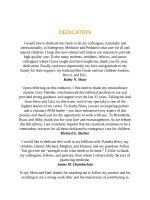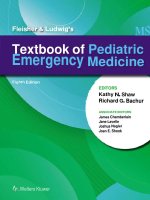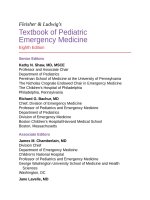Pediatric emergency medicine trisk 0342 0342
Bạn đang xem bản rút gọn của tài liệu. Xem và tải ngay bản đầy đủ của tài liệu tại đây (76.71 KB, 1 trang )
allowable. Any law that contradicts or conflicts with EMTALA is considered
preempted by EMTALA.
The HIPAA of 1996 also impacts the traditional transport system. Limitations
are placed on information dispersion that could be potentially linked to a specific
patient. Although this should not impact patient information flow between
primary providers or the assessment of services by an established CQI system, the
generic follow-up letters that many systems used for feedback and as marketing
tools are no longer permitted. Legal advice should be sought on how to replace
this time-honored, but now outdated, method of generic communications.
As noted, traditional tort law also applies to the transport team. Most of these
issues are similar to those encountered in other healthcare venues. However, one
potential source of medical–legal risk is unique to the transport team. As stated
earlier, the transport team gradually becomes more and more involved in the care
of the patient. At first, this involvement is limited to giving advice and
management suggestions. It is the referring physician’s responsibility to consider
these suggestions as he or she deems appropriate. At this stage in the transport
process, transport personnel should try to gain the clearest possible picture of the
patient’s condition so the most appropriate suggestions may be given.
Furthermore, advice may be best prefaced with general phrases such as “Most
patients with this condition” or “We often manage this problem by …” The
transport team should clearly document any advice given, in writing or recorded
conversations, in case disagreements regarding what advice was given arise later.
The next stage of involvement occurs when the transport team arrives at the
referral facility and begins to care for the patient, often along with one or more
members of the referring hospital’s staff. At this point, the greatest medical–legal
risks are conflicts over management and difficulties in determining who gave or
carried out medical orders. Written consent and permission for disseminating
medical-related information should be obtained, and if the patient/guardian is
unable to provide it, alternative means of approving the transport should be
considered ( Figs. 11.12 and 11.13 ). When management conflicts arise, the
medical control physician should be contacted, and he or she should help resolve
these conflicts by speaking directly with the referring physician. In these
situations, the referring provider is ultimately in charge of the patient, and the
transport providers are considered onsite consultants. The medical record should
clearly reflect who gave and who carried out each order.
The transport team assumes total responsibility for the care of the patient when
they leave the referral center. Consequently, the team should assure that the
patient is as stable as possible before leaving. If an unstable patient is transported,









